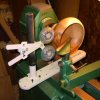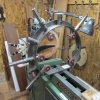Doug......
I contemplated using two sets of Oneway bowl steady wheels on a single mount, just as you are doing.......and, Charlie has done.
My decision was to bite the bullet, and get a full steady rest. I ended up special ordering a five station rest from Clark.....he advertises under the "spin doctor" name in the AAW magazine.
Now....here's the big question: Does more wheels work for eliminating vibration? It does, but to varying degrees. It depends on many things like species, thickness, shape, turning speed, degree of warp, distance from bowl rim to spindle, etc......
MM is correct that the wheels closest to the cutting action do the most good, but the wheels furthest from the cut also help, but to a lesser degree. For smaller and shallow bowls, I don't think it's worth the effort to use any more than the original two-wheel Oneway outfit. Some large, thin, and tall bowls do definitely benefit from wheels positioned around the circumference.....Not in every single case, but enough to make it worth while to find out.
This is my theory: I believe the vibration emanating from a cut is shaped something like a V, and resembles a wake behind a boat......it gets less intense the further away from the cut, but is still present around the entire circumference. I have no way of knowing how true that is, but I've found that difficult bowls do benefit from the full steady rest, whereas the Oneway bowl steady might do 90 percent of what the full steady rest will do.
Everything is going to boil down to what it's worth to you to get that last little bit of benefit from additional wheels. (I've added a photo of a bowl that I just don't think I could have done as thin as I did, without the Clark full steady rest. It was spalted, thin and fairly large and tall......everything that makes for difficult cutting without tearout and need to over-sand for a fine finish.) It's bowls like this one that makes the expense of having the two bowl rests worth it for me.......at this point, I don't consider how much these rests cost me, all I consider is the benefit of having them. It's like getting a quality lathe.......once you own it, the money you spent is no longer what is important to you!

For my purposes, I don't bother using either of the bowl rests for roughing bowls, because the fineness of the cut is not as important as for final finish tool work. Final finish tool work is where I use the Oneway and Clark steady rests. The Oneway is used almost always, for all bowls. The Clark rest is only used occasionally. Those who regularly turn extra large and tall turnings, will probably have different requirements than I do.
Sometimes, the Oneway is used on the back side of the bowl when final tool finish is being done to the outside. Not always, but sometimes that works to better the cut, even though the wheels are on the opposite side.
I have no idea how well two Oneway bowl steadys on a single mount would work out. Maybe Charlie can tell you what problems there is, and what the min/max will be. My guess is the scissor action will only give you an inch or two in size adjustment........after that, you'll be unbolting the post and repositioning it........I suspect that would be a hassle. Regardless of that, I'd guess two Oneway bowl steadys would probably work about as well as a full circumference bowl steady.......just my guess.
Good luck in whatever you decide.......
ooc




